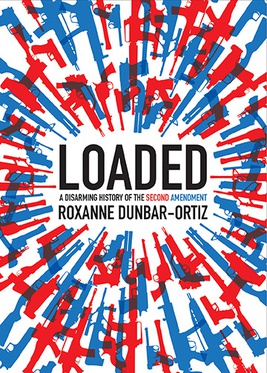Loaded: A Disarming History of the Second Amendment facts for kids
 |
|
| Author | Roxanne Dunbar-Ortiz |
|---|---|
| Cover artist | Herb Thornby |
| Country | United States |
| Language | English |
| Genre | History |
| Publisher | City Lights Books, San Francisco |
|
Publication date
|
2018-01-23 |
| Media type | Print (paperback, Kindle & audio) |
| Pages | 236 |
| OCLC | 1035450533 |
Loaded: A Disarming History of the Second Amendment is a book by the historian Roxanne Dunbar-Ortiz. It was published by City Lights Books. The book explores the history of the Second Amendment to the United States Constitution.
Dunbar-Ortiz looks at the Second Amendment from a new angle. She is not a fan of guns. However, she avoids common political arguments. Instead, she uses her skills as a historian. She uncovers surprising facts about how the Second Amendment came to be.
Contents
About the Book
Loaded starts with the author sharing her own experiences. She talks about how she once felt about guns. This personal story helps her begin a wider look at why guns are so important in the U.S. She explores where this strong connection to guns comes from.
The book has nine chapters. Each chapter describes how a "dangerous gun culture" developed. This culture is closely linked to the Second Amendment. The author argues it has supported certain ideas. These include white nationalism and social control through violence.
Early History of the Second Amendment
Chapters One and Two discuss the early role of the Second Amendment. They explain how it allowed settlers to form volunteer groups. These groups were used in conflicts over land. They also helped control certain populations. This was important for the U.S. as it expanded across the continent.
Dunbar-Ortiz challenges some common ideas about the Second Amendment. She shows that it gave individuals the right to form these volunteer groups. These groups were often used to take land.
Chapter Three looks at less-known parts of the Second Amendment. It explains how citizens were sometimes required to help capture people escaping slavery. It also allowed slave owners to organize groups to enforce slavery.
Gun Culture and National Heroes
Chapters Four and Five explore how gun culture became popular. Many American children played games like "cowboys and Indians." Figures like Quantrill's Raiders and Jesse James became famous. They were sometimes seen as heroes, like Robin Hood.
The book also looks at the idea of "the hunter." Figures like Daniel Boone were romanticized. Gun use was celebrated during a time when the U.S. was expanding.
Modern Views on Gun Rights
Chapter Six discusses how the right to bear arms is viewed in the U.S. It is often seen as a very important right. Some people treat it almost like a sacred agreement.
Chapters Seven and Eight connect the rise in mass shootings in the U.S. to other trends. These include the growth of groups that support gun rights. They also link to the increase of white nationalist groups.
Chapter Nine explores why many people resist understanding this history. Both those for and against gun control often overlook these connections. They do not see the link between the Second Amendment and white nationalism.
Overall, the book aims to face important parts of U.S. history. These parts are tied to the original meaning of the Second Amendment. They are often ignored or denied.

